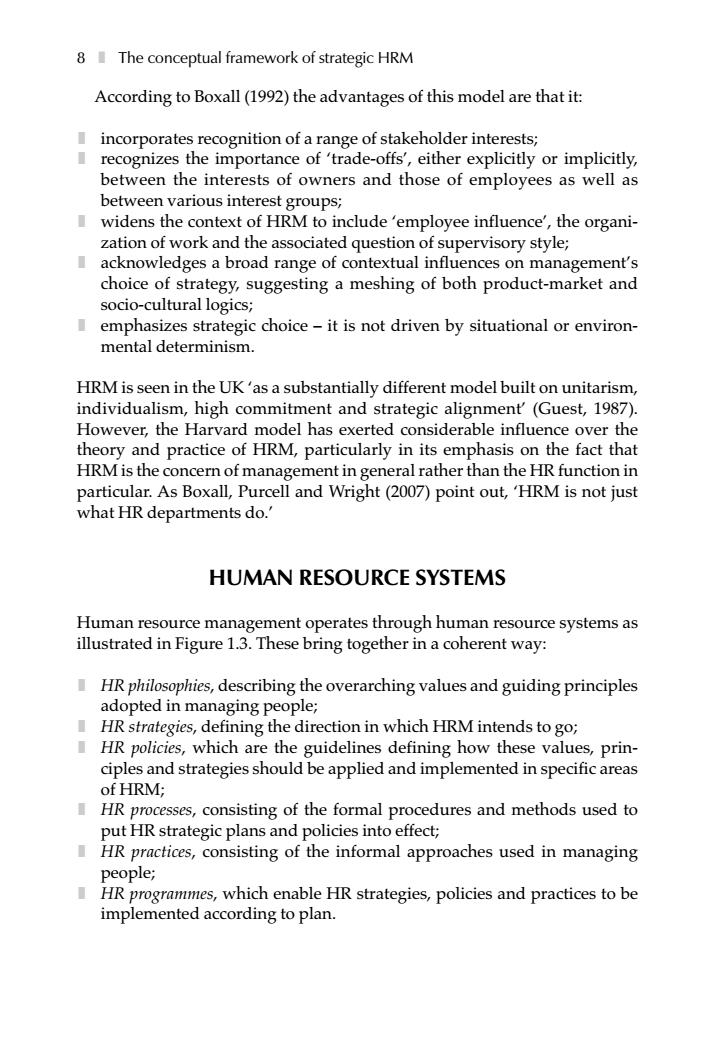正在加载图片...

8 The conceptual framework of strategic HRM According to Boxall(1992)the advantages of this model are that it: incorporates recognition of a range of stakeholder interests; recognizes the importance of 'trade-offs',either explicitly or implicitly, between the interests of owners and those of employees as well as between various interest groups; widens the context of HRM to include 'employee influence',the organi- ation of work and the associated question ofs supervisory style; acknowledges a broad range of contextual influences on management's choice of strategy,suggesting a meshing of both product-market and socio-cultural logics: emphasizes strategic choice-it is not driven by situational or environ mental determinism. HRMisseen in the UK'as a substantially different model unitaris m individualism,high commitment and strategic alignment'(Guest,1987). However,the Harvard model has exerted considerable influence over the theory and practice of HRM,particularly in its emphasis on the fact that HRMis the concem of management in general rather than the HR function in particular.As Boxall,Purcell and Wright(2007)point out,'HRM is not just what HR departments do.' HUMAN RESOURCE SYSTEMS Human re source manage ment operates through human resource systems as illustrated in Figure 1.3.These bring together in a coherent way: HR philosophies,describing the overarching values and guiding principles adopted in managing people; HR strategies,defining the direction in which HRM intends to go; HR policies,which are the guidelines defining how these values,prin ciples and strategies should be applied and implemented in specific areas of HRM; HR processes,consisting of the formal procedures and methods used to HR practices,consisting of the informal approaches used in managing people; which enable HR strategies,policies and practices to be implemented according to plan.According to Boxall (1992) the advantages of this model are that it: l incorporates recognition of a range of stakeholder interests; l recognizes the importance of ‘trade-offs’, either explicitly or implicitly, between the interests of owners and those of employees as well as between various interest groups; l widens the context of HRM to include ‘employee influence’, the organization of work and the associated question of supervisory style; l acknowledges a broad range of contextual influences on management’s choice of strategy, suggesting a meshing of both product-market and socio-cultural logics; l emphasizes strategic choice – it is not driven by situational or environmental determinism. HRM is seen in the UK ‘as a substantially different model built on unitarism, individualism, high commitment and strategic alignment’ (Guest, 1987). However, the Harvard model has exerted considerable influence over the theory and practice of HRM, particularly in its emphasis on the fact that HRM is the concern of management in general rather than the HR function in particular. As Boxall, Purcell and Wright (2007) point out, ‘HRM is not just what HR departments do.’ HUMAN RESOURCE SYSTEMS Human resource management operates through human resource systems as illustrated in Figure 1.3. These bring together in a coherent way: l HR philosophies, describing the overarching values and guiding principles adopted in managing people; l HR strategies, defining the direction in which HRM intends to go; l HR policies, which are the guidelines defining how these values, principles and strategies should be applied and implemented in specific areas of HRM; l HR processes, consisting of the formal procedures and methods used to put HR strategic plans and policies into effect; l HR practices, consisting of the informal approaches used in managing people; l HR programmes, which enable HR strategies, policies and practices to be implemented according to plan. 8 l The conceptual framework of strategic HRM